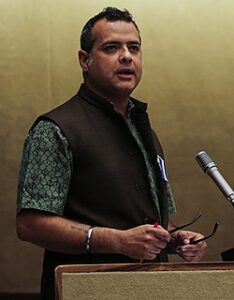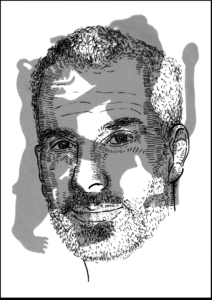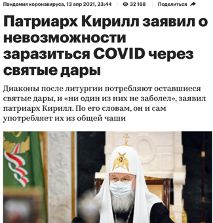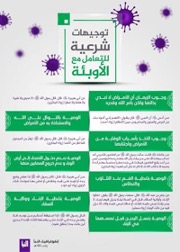
Gerald Epstein is Professor of Economics and a founding Co-Director of the Political Economy Research Institute (PERI) at the University of Massachusetts, Amherst.
Three banks in the U.S. (Silicon Valley Bank, Signature Bank and Silvergate) have collapsed since early March. The collapses of Silicon Valley Bank and Signature Bank are the two biggest bank failures since 2008. Silicon Valley Bank had deep ties to the high-tech industry while Signature Bank and Silvergate were some of the world’s biggest crypto-friendly banks. So, why are banks collapsing now? Is there a banking crisis underway? Moreover, are government bailouts back? Leading progressive economist Gerald Epstein addresses these and other questions in this exclusive interview for Truthout. Gerald Epstein is professor of economics and co-director of the Political Economy Research Institute (PERI) at the University of Massachusetts Amherst, and author of a forthcoming book from the University of California Press titled, Busting the Bankers’ Club: Finance For the Rest of Us.
C.J. Polychroniou: In 2007, the biggest financial crisis since the Great Depression erupted in the U.S. and, within a couple of years, it rippled across the globe with ramifications which, in some instances, have yet to be resolved. Indeed, many analysts have been suggesting all along that the next financial crisis was just waiting to happen because the necessary structural changes to the banking system were never put in place. Now, it seems that the critics were right: On March 10, 2023, Silicon Valley Bank (SVB) collapsed due to a classic bank run and its inability to raise capital. Moreover, a couple of days earlier, California-based Silvergate Bank had also folded and on March 12, the New York-based Signature Bank, which had over $100 billion in assets, became the next casualty. What caused SVB, which was the 16th largest bank in the U.S., to collapse?
Gerald Epstein: There are five main causes of the SVB collapse and the subsequent knock-on problems facing the U.S. and global financial system: the Federal Reserve’s anti-inflation obsession causing it to raise interest rates too high and too fast; the inherent fragility of banking, which for centuries has periodically erupted in crises; inadequate regulation of this fragile system, which often leads to high profits that accrue to banks and their wealthy owners; the corruption and self-dealing that often result from banks’ insufficient supervision; and the lack of public alternatives for financial institutions and services that could perform many of the key functions of banking and finance with less risk and without the private financiers taking their cut. Some of the huge profits financiers make from this system are funneled to buy support from politicians to prevent adequate regulation, and to secure bailouts when the system crashes.
This structure produces failures in various ways and forms. The causes of SVB’s failure are both old school and new dawn — with these two being intertwined and intermingled — creating an old vintage brew poured into new, high-tech bottles. The bank’s investments (assets) were concentrated in a single industry — technology start-ups — that had been booming for several years but then dramatically slowed down, reducing business and income for SVB. To bolster its profits, SVB invested in risky financial assets to enhance short term returns: in this case it invested in long-term U.S. government bonds (and government guaranteed mortgage bonds) that were highly rated (AAA) but had high risks of loss if interest rates went up significantly. In its overzealous attempt to fight inflation, the Fed raised interest rates by more than 4 percentage points within a year, causing the market value of the government’s long-term bonds to plummet. This would not have created problems if SVB had held onto these bonds to term (e.g., 10 years). But, the bank funded these start-ups and bond investments with significant amounts of potentially flighty short-term debt — in this case, large amounts of uninsured deposits lent to the bank by Silicon Valley–oriented venture capital firms (VCs) and their customers (“founders” or “start-ups”). This means that the bank funded its risky investments with flighty debt rather than from its owners’ equity capital. In other words, the bank had high levels of “leverage” (debt relative to assets) based on debts (deposits) that could be demanded back from the bank at a moment’s notice.
Sensing problems with the bank, or just wanting to move their funds to earn higher interest rates, the VC investors began taking their money out of SVB and, as a result, SVB had to sell its government bonds at a loss in order to pay them back their deposits. These losses on the bonds cut into SVB’s capital. When SVB tried to raise more capital in order to cover these losses, this raised eyebrows about the solvency of the firm. VC firms withdrew millions of dollars and told their “start-ups” to take their money and run. When the Federal Deposit Insurance Corporation (FDIC) took control of SVB on March 10, SVB was the 16th-largest bank in the U.S., with over $200 billion in assets, and its collapse was the largest since Washington Mutual in 2008. (For context, the largest U.S. bank is JPMorgan-Chase with $3.2 trillion).
Elizabeth Warren, Bernie Sanders, and many others (law professor Jennifer Taub, Lisa Donner of Americans for Financial Reform and Dennis Kelleher of Better Markets, to name a few) are pointing to the Trump-era partial deregulation of medium-sized banks (less than $250 billion in assets), which contributed to SVB’s failure. SVB’s capital and liquidity requirements were reduced, mandatory stress tests were eliminated, the rules against proprietary trading (the Volcker Rule) were suspended, and the need to prepare plans in case the bank became insolvent (so-called ‘living wills’) was eliminated. These stricter rules would have made it much more likely that the problems with SVB would have been dealt with by the Federal Reserve and FDIC sooner and in a much less disruptive way. Right after Lehman Brothers collapsed in 2008, the Queen of England asked economists at the London School of Economists how they had all missed the warning signs. Many are now asking the same of the Federal Reserve Board and the Federal Reserve Bank of San Francisco that were supposed to be supervising SVB. It turns out that they did know of these problems at least a year ago, but, it seems, only offered toothless warnings.
This lack of serious attention reminds me of the Carmen Segarra saga after the great financial crisis. Segarra was hired to be the New York Federal Reserve monitor/supervisor onsite at Goldman Sachs in 2011. She saw first-hand the lack of risk controls at Goldman and the obsequious behavior of the other New York Fed monitors who seemed more interested in gaining favor with Goldman than protecting the public. Segarra was fired after repeatedly complaining about the lack of serious Fed supervision of Goldman. One wonders if the San Francisco Fed has put on a repeat performance.
Greg Becker, SVB’s CEO, had lobbied Congress for the Trump-era deregulation bill. He also sat on the board of directors of the Federal Reserve Bank of San Francisco up until the day the bank collapsed.
In the cases of SVB and Signature Bank, FDIC insurance will cover all depositors regardless of size, but the Biden administration says this does not amount to a bailout. Does this sound right? I mean, if the U.S. government steps in to shore up deposits in failed banks, doesn’t such a move qualify as a bailout? And who ultimately benefits from a bailout?
This question of whether the FDIC’s after-the-fact decision to cover all of SVB’s and Signature’s deposits — plus, the decision by Federal Reserve to create a special facility to lend money to banks that hold long-term government bonds, dollar for dollar at the original value of the bonds — constitutes a “bailout” is politically and morally fraught, and the discussion of it has, generally, been full of bluster with only a few illuminating contributions.
The term “bailout” is not a technical term; it is a colloquial term. Since at least the 2008 crisis, it has had a largely pejorative connotation, and suggests that someone has been compensated even though they should have known, or did know, better. Worse, perhaps they did something illicit and were still getting compensation from the government. In this meaning, bailout suggests a rescue so that these people will not have to bear the consequences of their acts. This rescue will make it more likely that they will do this irresponsible and costly action again (leading to what economists and insurance companies call “moral hazard”). After 2008, there was a widespread view that “Wall Street got bailed out and Main Street did not.” This really angered people and contributed to the rise of the “Tea Party” and later, to more perverse and dangerous incarnations. No government wants to be accused of doing bank bailouts again, including Joe Biden. Has he, or hasn’t he?
Let’s use an analogy to see if that helps us decide. Say there is a fierce hurricane that hits Miami. Compare three people. One has a house in the middle of town, and it gets destroyed. Say this person could not afford hurricane insurance. If the government comes in and gives this person compensation to help his family get back on their feet, do we think most Americans will call this a bailout? I don’t think so. It is a rescue, or aid. Let’s say another person built a house on the beach. Their house gets swamped. The government gives them compensation, without the condition that they can’t build on the beach again. Will people call this a bailout? Maybe. Then there is a third case. A big property developer who builds a huge apartment complex on the beach, a complex that erodes the beach and makes it easier for high waters to come off the ocean into the complex and the neighbors’ apartments as well. The hurricane wrecks the complex and the neighbors’ apartments, and the building developer gets compensation from the government. Will people call this a bailout? No question. And moral hazard? Definitely. The builder will just do it again with bad implications for him and his neighbors.
Let’s apply this analogy to SVB. The management and owners made bad and irresponsible decisions. The government fired the management and is giving no compensation to the bank’s owners (or other big non-depositor creditors). No bailout here. The FDIC is compensating the startups that had more than $250,000 in the bank, either because they had nowhere else to easily park their payroll and reserves, or because SVB or their VCs forced them to keep their money on deposit at SVB. Are they being bailed out or aided/rescued? I would say that most Americans who understood this situation would say no bailout here. What about the venture capitalists who made multimillion-dollar deposits into SVB, presumably in exchange for benefits from the bank, and some of whom rapidly pulled their money out and told their start-ups to do likewise. The FDIC is making them whole if they did not manage to get all their money out. This smells like a bailout to me.
There are other interesting cases that do not fit into a neat box. Little commented on, the SVB depositor rescue by the FDIC constitutes the first bailout of a major cryptocurrency firm. Circle — the issuer of its crypto-connected “stable-coin,” USD Coin (USDC) — had deposits of more than $3 billion in SVB. These are Circle’s U.S. dollar assets that they use to try to maintain a 1-to-1 dollar peg between their “stable” coin and the U.S. dollar. When SVB went under, USDC dropped off its peg to about 80 cents. U.S. financial regulators such as Securities and Exchange Commission Chair Gary Gensler had warned that these so-called stable coins were unstable and could only be made stable with bail-outs. They found evidence right here. And these regulators should nip this dangerous “financial innovation” in the bud before it causes more problems.
The FDIC will not get the funds to compensate these depositors by raising taxes but by assessing the banks. But small community banks are asking: Why should we bail out these massive VC firms? Shouldn’t the big VC investors, like Peter Thiel, get assessed for these costs?
But even the claim that the executives of SVB are not getting bailed out is questionable. No one doubts that they are largely responsible for the debacle. But it is not true that they are not getting rescued. Senators Elizabeth Warren and Richard Blumenthal have put together a whole rap sheet on possible self-dealing and wealth-grabbing by CEO Gregory Becker and other top management that contributed to SVB’s demise. These include stock sales in the weeks before the collapse and significant bonuses just before the FDIC take over. Warren, Blumenthal, Biden, and others have called for “clawbacks” of ill-gotten gains from bank executives in these situations.
The bottom line, in my view, is that there have been serious bailouts here and more will probably be discovered; but it is not correct to paint all those with large deposits who got rescued as being “bailed out.” There is a structural problem in our current financial system. There needs to be a safe place for businesses to place their reserves and working capital without providing funds to speculative financiers, and without fear that their deposits will be wiped out in a bank failure. That, among other reasons, is why we need publicly provided accounts where households and businesses can hold their money, risk-free.
Given where things stand at the present time, would you say that a banking crisis is under way? Moreover, is there a connection between the SVB collapse and the state of the U.S. economy?
There is a banking crisis underway. I don’t think it will have the strength or reach of the 2008 crisis, but the problems have spread. There is a two-way street between these banking problems and the overall economy. On the one hand, the rapid increase in central bank interest rates to fight inflation is a major precipitating factor driving the financial problems. This interest rate overshooting by the Fed is, as my colleague Bob Pollin and his co-author Hanae Bouazza have shown, due to its wrong-headed commitment to driving inflation down to an arbitrary 2 percent target. These high interest rates and the banking problems partially caused by them will probably restrict useful lending to the economy and may make a recession more likely.
The general consensus so far is that the SVB collapse will have minimal impact on global markets and global financial institutions. Be that as it may, it seems that the U.S. banking system has learned no lessons from the 2007-2008 financial crisis. If this is so, is the problem with private institutions geared toward the pursuit of profit at any cost, or with public policy?
Yes. That is clearly a big part of the problem. A healthy economy needs a set of basic institutions that provide financial services to families and businesses that facilitate their productive and necessary activities. The problem with private, more speculative banks like the big banks that dominate our economy is that they provide lousy and costly services to most families and smaller businesses. And as SVB shows, sometimes these deposit accounts for families and businesses are held alongside large speculative deposits that fund speculative investments that put the whole bank at risk.
At a minimum, we need to restore the levels of financial regulation we had after the Dodd-Frank Act was implemented, but this is not enough. We have to have public provision of basic financial services, such as Federal Reserve Accounts, and/or a postal banking system where anyone can have risk free deposit accounts and, in the latter case, households can get basic banking services. Public banks at the state, municipal or regional level are another example of financial institutions that can provide loans and other financial services insulated from the negative aspects of the profit motive of private banking.
And we need to regulate the regulators, like the Federal Reserve, to prevent them from doing the bidding of the banks. Major structural changes need to be implemented, but I am afraid these issues are beyond the scope of this interview.
Copyright © Truthout. May not be reprinted without permission.
C.J. Polychroniou is a political scientist/political economist, author, and journalist who has taught and worked in numerous universities and research centers in Europe and the United States. Currently, his main research interests are in U.S. politics and the political economy of the United States, European economic integration, globalization, climate change and environmental economics, and the deconstruction of neoliberalism’s politico-economic project. He is a regular contributor to Truthout as well as a member of Truthout’s Public Intellectual Project. He has published scores of books and over 1,000 articles which have appeared in a variety of journals, magazines, newspapers and popular news websites. Many of his publications have been translated into a multitude of different languages, including Arabic, Chinese, Croatian, Dutch, French, German, Greek, Italian, Japanese, Portuguese, Russian, Spanish and Turkish. His latest books are Optimism Over Despair: Noam Chomsky On Capitalism, Empire, and Social Change (2017); Climate Crisis and the Global Green New Deal: The Political Economy of Saving the Planet (with Noam Chomsky and Robert Pollin as primary authors, 2020); The Precipice: Neoliberalism, the Pandemic, and the Urgent Need for Radical Change (an anthology of interviews with Noam Chomsky, 2021); and Economics and the Left: Interviews with Progressive Economists (2021).










